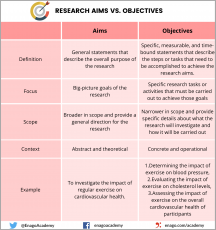Research Aims and Objectives: The dynamic duo for successful research

Picture yourself on a road trip without a destination in mind — driving aimlessly, not knowing where you’re headed or how to get there. Similarly, your research is navigated by well-defined research aims and objectives. Research aims and objectives are the foundation of any research project. They provide a clear direction and purpose for the study, ensuring that you stay focused and on track throughout the process. They are your trusted navigational tools, leading you to success.
Understanding the relationship between research objectives and aims is crucial to any research project’s success, and we’re here to break it down for you in this article. Here, we’ll explore the importance of research aims and objectives, understand their differences, and delve into the impact they have on the quality of research.
Understanding the Difference between Research Aims and Objectives
In research, aims and objectives are two important components but are often used interchangeably. Though they may sound similar, they are distinct and serve different purposes.
Research Aims:
Research aims are broad statements that describe the overall purpose of your study. They provide a general direction for your study and indicate the intended achievements of your research. Aims are usually written in a general and abstract manner describing the ultimate goal of the research.
Research Objectives:
Research objectives are specific, measurable, and achievable goals that you aim to accomplish within a specified timeframe. They break down the research aims into smaller, more manageable components and provide a clear picture of what you want to achieve and how you plan to achieve it.

In the example, the objectives provide specific targets that must be achieved to reach the aim. Essentially, aims provide the overall direction for the research while objectives provide specific targets that must be achieved to accomplish the aims. Aims provide a broad context for the research, while the objectives provide smaller steps that the researcher must take to accomplish the overall research goals. To illustrate, when planning a road trip, your research aim is the destination you want to reach, and your research objectives are the specific routes you need to take to get there.
Aims and objectives are interconnected. Objectives play a key role in defining the research methodology, providing a roadmap for how you’ll collect and analyze data, while aim is the final destination, which represents the ultimate goal of your research. By setting specific goals, you’ll be able to design a research plan that helps you achieve your objectives and, ultimately, your research aim.
Importance of Well-defined Aims and Objectives
The impact of clear research aims and objectives on the quality of research cannot be understated. But it’s not enough to simply have aims and objectives. Well-defined research aims and objectives are important for several reasons:
- Provides direction: Clear aims and well-defined objectives provide a specific direction for your research study, ensuring that the research stays focused on a specific topic or problem. This helps to prevent the research from becoming too broad or unfocused, and ensures that the study remains relevant and meaningful.
- Guides research design: The research aim and objectives help guide the research design and methodology, ensuring that your study is designed in a way that will answer the research questions and achieve the research objectives.
- Helps with resource allocation: Clear research aims and objectives helps you to allocate resources effectively, including time, financial resources, human resources, and other required materials. With a well-defined aim and objectives, you can identify the resources required to conduct the research, and allocate them in a way that maximizes efficiency and productivity.
- Assists in evaluation: Clearly specified research aims and objectives allow for effective evaluation of your research project’s success. You can assess whether the research has achieved its objectives, and whether the aim has been met. This evaluation process can help to identify areas of the research project that may require further attention or modification.
- Enhances communication: Well-defined research aims and objectives help to enhance communication among the research team, stakeholders, funding agencies, and other interested parties. Clear aims and objectives ensure that everyone involved in your research project understands the purpose and goals of the study. This can help to foster collaboration and ensure that everyone is working towards the same end goal.
How to Formulate Research Aims and Objectives
Formulating effective research aims and objectives involves a systematic process to ensure that they are clear, specific, achievable, and relevant. Start by asking yourself what you want to achieve through your research. What impact do you want your research to have? Once you have a clear understanding of your aims, you can then break them down into specific, achievable objectives. Here are some steps you can follow when developing research aims and objectives:
- Identify the research question: Clearly identify the questions you want to answer through your research. This will help you define the scope of your research. Understanding the characteristics of a good research question will help you generate clearer aims and objectives.
- Conduct literature review: When defining your research aim and objectives, it’s important to conduct a literature review to identify key concepts, theories, and methods related to your research problem or question. Conducting a thorough literature review can help you understand what research has been done in the area and what gaps exist in the literature.
- Identify the research aim: Develop a research aim that summarizes the overarching goal of your research. The research aim should be broad and concise.
- Develop research objectives: Based on your research questions and research aim, develop specific research objectives that outline what you intend to achieve through your research. These objectives should be specific, measurable, achievable, relevant, and time-bound (SMART).
- Use action verbs: Use action verbs such as “investigate,” “examine,” “analyze,” and “compare” to describe your research aims and objectives. This makes them more specific and measurable.
- Ensure alignment with research question: Ensure that the research aim and objectives are aligned with the research question. This helps to ensure that the research remains focused and that the objectives are specific enough to answer your research question.
- Refine and revise: Once the research aim and objectives have been developed, refine and revise them as needed. Seek feedback from your colleagues, mentors, or supervisors to ensure that they are clear, concise, and achievable within the given resources and timeframe.
- Communicate: After finalizing the research aim and objectives, they should be communicated to the research team, stakeholders, and other interested parties. This helps to ensure that everyone is working towards the same end goal and understands the purpose of the study.
Common Pitfalls to Avoid While Formulating Aims and Objectives
There are several common mistakes that researchers can make when writing research aims and objectives. These include:
- Being too broad or vague: Aims and objectives that are too general or unclear can lead to confusion and lack of focus. It is important to ensure that the aims and objectives are concise and clear.
- Being too narrow or specific: On the other hand, aims and objectives that are too narrow or specific may limit the scope of the research and make it difficult to draw meaningful conclusions or implications.
- Being too ambitious: While it is important to aim high, being too ambitious with the aims and objectives can lead to unrealistic expectations and can be difficult to achieve within the constraints of the research project.
- Lack of alignment: The aims and objectives should be directly linked to the research questions being investigated. Otherwise, this will lead to a lack of coherence in the research project.
- Lack of feasibility: The aims and objectives should be achievable within the constraints of the research project, including time, budget, and resources. Failing to consider feasibility may cause compromise of the research quality.
- Failing to consider ethical considerations: The aims and objectives should take into account any ethical considerations, such as ensuring the safety and well-being of study participants.
- Failing to involve all stakeholders: It’s important to involve all relevant stakeholders, such as participants, supervisors, and funding agencies, in the development of the aims and objectives to ensure they are appropriate and relevant.
To avoid these common pitfalls, it is important to be specific, clear, relevant, and realistic when writing research aims and objectives. Seek feedback from colleagues or supervisors to ensure that the aims and objectives are aligned with the research problem, questions, and methodology, and are achievable within the constraints of the research project. It’s important to continually refine your aims and objectives as you go. As you progress in your research, it’s not uncommon for research aims and objectives to evolve slightly, but it’s important that they remain consistent with the study conducted and the research topic.
In summary, research aims and objectives are the backbone of any successful research project. They give you the ability to cut through the noise and hone in on what really matters. By setting clear goals and aligning them with your research questions and methodology, you can ensure that your research is relevant, impactful, and of the highest quality. So, before you hit the road on your research journey, make sure you have a clear destination and steps to get there. Let us know in the comments section below the challenges you faced and the strategies you followed while fomulating research aims and objectives! Also, feel free to reach out to us at any stage of your research or publication by using #AskEnago and tagging @EnagoAcademy on Twitter, Facebook, and Quora. Happy researching!










This particular material has added important but overlooked concepts regarding my experiences in explaining research aims and objectives. Thank you
the idea is so good. its really helps for some research.